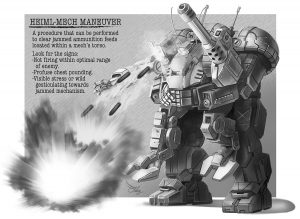Cold Wars
Sarna News

- Bad ‘Mechs - Sentinel
- HEXTECH Review - Wave 3 Brings More Urban Options To Your Battlefield
- Your BattleTech News Round-Up For March, 2024
- Crashing 'Mechs With Jennifer Brozek, Author Of The Rogue Academy Trilogy
- Getting The Word Out With Rem Alternis, Catalyst Community & Marketing Director
- Read more →
The two Terran Cold Wars were the predominant global conflicts of the middle twentieth and early twenty-first centuries.
Contents
First Cold War[edit]
The First Cold War (1946–1988) emerged in the aftermath of World War II.[1][2]
The communist and capitalist blocs, heralded by the Union of Socialist Soviet Republics (USSR) and United States of America (USA), entered into a prolonged ideological, political, and economical competition. Unlike previous wars, where the threat of mutual nuclear annihilation did not yet exist, the Cold War was mainly fought through proxy and economic wars. Both ideological blocks coalesced into treaty organizations, the Warsaw Pact Nations on the one hand and the North Atlantic Treaty Organization (a predecessor of the Western Alliance) on the other.[1]
Eventually, the arms race escalated into a space race. While the USSR was the first to put a man into space, the USA put the first man on Luna, the Terran moon.[1] Soon, space-based weapons like the Excalibur satellites were developed by the USA to counter the USSR's ever increasing nuclear arsenal and newly-developed accurate missile delivery systems.[2]
Thanks to the ever increasing armament costs and the militarization of space, the economy of the Soviet Union finally collapsed in 1988, and a reform government under Mikhael Gorbachev took power on the 11th of January. The Soviet Union was officially disbanded and Russian troops began leaving the Warsaw Pact nations.[2]
Interbellum[edit]
With the sudden end of the First Cold War, the victorious powers drastically cut their military funding, which promptly led to a global recession. Experienced Western politicians cut taxes, encouraged trade, and finished building the last big weapon and defense systems (like Crippen Station). The successor of the Soviet Union, the Russian Federation, was not so lucky. While attempting to reform the Russian Federation into a capitalist nation, Russia's leadership merely aped the most libertarian policies of the NATO states. These poorly implemented changes, coupled with an increased need to maintain internal and external power projection and keep restless satellites such as the Afghan SSR in line, ensured that Russia was plunged into a deep depression.[2]
Second Cold War[edit]
The Second Cold War (1997–2005) was the continuation of the First Cold War. [2]
After the Soviet Union was reestablished by a hardliner coup in 1997, tensions between the newly-renamed Republic of Russia and the NATO member states steadily escalated after the re-occupation of the Warsaw Pact nations. Initially, neither side was militarily strong enough to escalate the conflict beyond posturing. However, Russian economic weakness was masked with military saber-rattling and by 2004 World War III seemed to be imminent.[2]
In the end, even the most hardline Soviet politicians realized that the Soviet Union was economically bankrupt, militarily weak, and politically moribund. The Second Cold War ended after the election of a compromise candidate, Oleg Tikonov, as the new Soviet Premier. Despite welcoming the de-escalation that had begun, NATO opted to launch the newly finished Crippen Station into orbit, where it formed the heart of the Western Orbital Defense Network.[2]
Aftermath[edit]
During his seven years in power Tikonov cautiously undertook demilitarization, liberalization, and rapprochement with NATO. His efforts at the latter culminated in January 2011 with the signing by the Soviet Union and the United States of the Tikonov Accords, cementing the promise of liberal reforms within the Warsaw Pact in exchange for financial assistance. Mere hours after the signing, Tikonov was assassinated and the Second Soviet Civil War began.[2]
Notes[edit]
As an alternate future, the BattleTech Universe and real life diverge in 1985. In real life, Gorbachev became Premier in this year rather than 1988, and the Cold War is usually believed to have ended at some point between 1989 (with the fall of the Berlin Wall) and December 1991 (when the Soviet Union itself peacefully dissolved).

